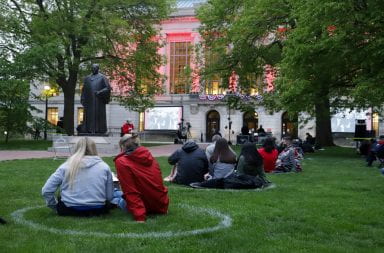Letter to the editor
Recently, I was contacted by a Lantern reporter about the dismal number of African-American students at Ohio State. Given that OSU’s main campus consists of nearly 60,000 students, the reporter wondered why there were relatively few African-American students enrolled at the university. Enrollment figures from Autumn 2011 show that, of the entire student body, only 3,274 were African-American. The reporter asked me why this is so. I reminded the reporter that the under-representation of African-American students at OSU is not new; indeed conversations with African-Americans who graduated from OSU as early as the late 1940s suggest that this development is historically consistent. Summarizing my response here (for the sake of time and space), my answer was an amalgamation of historical racism, the absence of vigilant recruitment efforts on the part of OSU and the need to introduce local kids to OSU at an early age; something that falls squarely within the mission and moral obligation of a land-grant university.
On this important question of African-American student enrollment at OSU, Mayor Michael Coleman also weighed in. According to the mayor, the reason for the low number of African-American students at OSU is that “young African-Americans are not well prepared for the college or working life after high school.” What? Sure that I had misread the quote, I repeated it again, this time aloud. This explains why African-American students are underrepresented at OSU? I said to myself, really? Coleman’s reckless comments are reminiscent of those made by Los Angeles Dodger executive Al Campanis while being interviewed by Ted Koppel on “Nightline” 25 years ago. Koppel asked Campanis what accounted for the dearth of African-American executives in Major League Baseball to which he replied, “because they aren’t qualified … they don’t have the skills to perform those kinds of jobs.” It wasn’t that Black applicants continued to get passed over for these jobs; instead it was because they weren’t well-equipped, Campanis believed. The backlash stemming from Campanis’ remarks was swift and unrelenting, ultimately costing him his job. While many found Campanis’ comments reprehensible, some (many of whom were African-American) were not surprised to learn that there were Americans who refused to let go of certain racial biases. After all, Campanis was old and white. Old customs die hard among this demographic.
Unlike Campanis, Coleman is African-American. Ohio State bears no responsibility for the disproportionate number of African-American students enrolled? Comments that put the onus on the aggrieved while absolving the institution of any responsibility are commonplace, especially when the aggrieved are African-American. While these types of comments are usually proffered by conservative whites like Al Campanis, Richard Herrnstein and Charles Murray (authors of “The Bell Curve”) and Abigail and Stephan Thernstrom, there is a core of curiously misguided Black officials and intellectuals who espouse similar rhetoric. In 1984, for example, Glenn Loury, a Black Harvard economist, spring-boarded into academic stardom when his article “A New American Dilemma,” appeared in “The New Republic.” In it, he addressed what he dubbed “fundamental failures in black society.” Loury spent considerable time lamenting “the lagging academic performance of black students.” Over the years, a number of wrong-headed Black intellectuals and officials have found acclaim by ignoring institutional racism, while at the same time putting the onus on those most adversely impacted by it.
Later in the Lantern article Coleman is quoted saying, “Many of our families need to do a better job intervening in their kids’ lives, especially as it pertains to their schoolwork and preparations for their future.” To his credit the mayor does go on to say that “we as a community – including the private sector, nonprofits and the government – need to determine how we can play a significant role to address this issue that is so important to our young people and so important to our future as a city.” On the latter point I could not agree more. The previous point, however, deserves rethinking. Many parents of all races could do a better job of involving themselves in their kids’ scholastic pursuits, but does this explain why African-American students are severely underrepresented at OSU?
Comments such as those made by the mayor are not only reckless, but dangerous, as political elites have the ability to shape and mold public opinion. Rather than advance the discussion with the expressed purpose of remedying the long-standing problem of Black under-representation at OSU, Coleman’s remarks deflected responsibility away from those most culpable – OSU administrators.
Judson Jeffries
Professor of African American and African Studies
Director of OSU’s Community Extension Center


